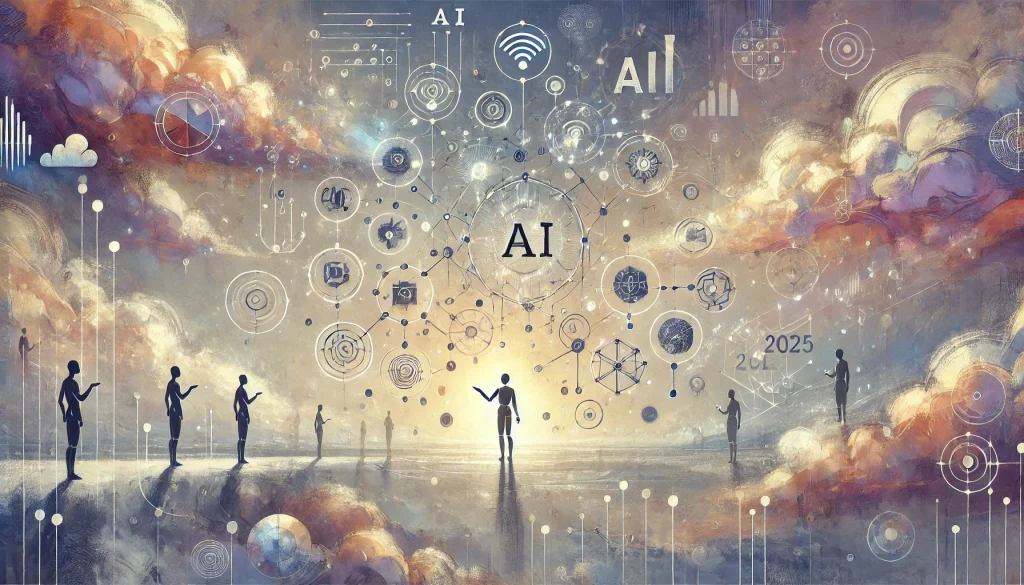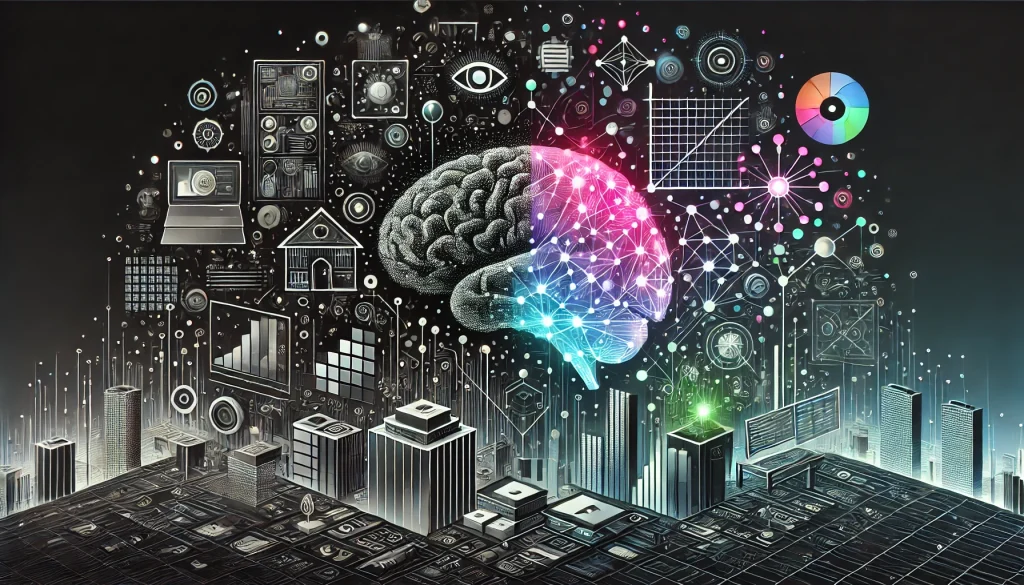- ✅ Learn the most important AI terms 2025 decision-makers need—without the technical jargon.
- 💡 Understand tools like ChatGPT, machine learning, NLP, and generative AI in plain English.
- 🧠 Avoid buzzword confusion and make smarter business decisions with this clear guide.

AI doesn’t have to be abstract — clarity begins with the right words.
Understanding AI Language: Essential Terms for Everyone
Artificial Intelligence is no longer some abstract thing in sci-fi movies. It’s part of the apps we open every day, the way our emails get sorted, how our phones autocomplete texts, and even the tools hiring managers use to screen resumes. But for most people, the biggest barrier to understanding AI isn’t the technology itself. It’s the vocabulary for AI terms 2025.
So, here’s your guide to the AI terms 2025 will be in regular circulation. We offer it without tech-snobbery. So you get straight-up explanations of what these words mean, why they matter, and where you’ve probably already seen them in action.
1. Artificial Intelligence (AI)
Let’s start with the term that gets thrown around the most. Artificial Intelligence is a catch-all for any system that can make decisions, solve problems, or mimic tasks that usually require human thinking.
It’s not one specific thing. It’s an umbrella term. A calculator doesn’t count as AI, but software that can spot cancer in a scan or generate a song from a text prompt does. Think of AI like electricity. It’s not a single tool but a power source for dozens of tools.
Where you see it: Google Search suggestions, spam filters, voice assistants like Alexa or Siri, photo tagging.
2. Machine Learning (ML)
This is one of the foundational AI terms 2025 readers will need to recognize when reading about anything related to automation or predictive systems. If AI is the big picture, machine learning is the method most often used to build it. Instead of giving a program fixed rules, machine learning means feeding it data so it can learn on its own.
Let’s say you want an app that tells cats and dogs apart. Instead of explaining every possible feature that defines a cat or a dog, you show the machine 10,000 labeled photos and let it figure out the patterns. It learns by example, not instruction.
Where you see it: Netflix recommending shows, YouTube’s algorithm, and fraud alerts from your bank.
3. Large Language Model (LLM)
LLMs are some of the most talked-about AI terms 2025 will continue to center in everything from workplace productivity to education and marketing. This is the tech behind ChatGPT, Gemini, Claude, and other AI chatbots. A Large Language Model is trained on huge amounts of text so it can predict what word should come next in a sentence. Over time, that simple process becomes powerful enough to write poems, explain quantum physics, or simulate a conversation. They don’t “know” things. They are just really good at pattern recognition. Think of it as autocomplete on steroids.
Where you see it: ChatGPT, Grammarly, AI writing assistants, code completion tools like GitHub Copilot.
4. Neural Network
The name sounds brainy, but don’t let it scare you off. Neural networks are a type of algorithm modeled loosely after how neurons fire in the brain. In practice, it’s a way of organizing calculations so a machine can learn from data in layers.
You’ve got an input layer (like raw data), hidden layers that process it, and an output (like a prediction). It’s the engine under the hood for many AI systems.
Where you see it: Facial recognition, self-driving cars, medical diagnosis tools.
5. Natural Language Processing (NLP)
Natural Language Processing is the field of AI that handles how machines read, interpret, and generate human language. It’s what allows a chatbot to understand your question or a translation app to switch between languages. For anyone trying to understand AI terms 2025 will highlight in content tools or communication software, NLP is high on that list. Without NLP, an AI wouldn’t know the difference between “book a flight” and “read a book.”
Where you see it: Google Translate, customer support bots, auto-correct, email filters.
6. Computer Vision
This is AI’s version of eyesight. Computer vision helps machines understand images and video. That means recognizing faces, identifying objects, scanning documents, and even interpreting hand gestures.
It’s often paired with deep learning (a type of machine learning using neural networks) to spot details the human eye might miss or simply automate tasks that would take people far too long.
Where you see it: Face unlock, traffic cameras, warehouse robots, and quality control in factories.
7. Generative AI
Generative tools are part of the AI terms 2025 will associate with creativity, productivity, and even risk when it comes to copyright. This is where things get weird in a good way, because Generative AI is trained to create. That might be a paragraph of text, a song, a painting, a 3D model, or even a video clip.
It doesn’t have imagination, though. It works by analyzing existing content and remixing patterns in ways that seem new-ish. Think of it like an extremely advanced collage artist, not an original thinker.
Where you see it: DALL·E, Midjourney, ChatGPT, Adobe Firefly, Runway ML.
8. Prompt Engineering
When AI models are sensitive to wording, your ability to ask the right question becomes an art form. That’s what prompt engineering is: knowing how to phrase your input to get the most accurate or useful result.
The same question, phrased slightly differently, can produce wildly different outcomes. So, learning how to talk to the AI, whether for writing, coding, or image generation, is often more valuable than the tool itself.
Where you see it: Every time someone says “I asked ChatGPT to…” on social media.
9. Training Data
AI doesn’t just “wake up” knowing things. It has to learn from something, and that something is called training data. For language models, it might be books, websites, and articles. For computer vision, it might be millions of labeled images.
Understanding how data gets fed into systems is part of decoding the AI terms 2025 will focus on in debates around fairness and regulation. The quality of training data determines how accurate or biased the system is. If the data is skewed, the AI will be too.
Where you see it: Behind the scenes of every AI tool. This is also where copyright and privacy debates start.
10. Bias in AI
Bias happens when an AI system produces unfair, inaccurate, or harmful results, often because of skewed training data or flawed assumptions in design.
Let’s say you train a hiring algorithm mostly on resumes from male applicants. The system might learn to favor them, even if it wasn’t explicitly told to. Bias isn’t intentional, but it’s real, and it can have real-world consequences.
Where you see it: Job screening, predictive policing, credit scoring.
11. Hallucination
In AI, “hallucination” doesn’t mean tripping out. It means making stuff up. Large language models sometimes generate information that sounds correct but isn’t based on fact.
For example, an AI might tell you that Marie Curie won three Nobel Prizes. That sounds plausible, but it’s not true. The model isn’t lying, however, it’s just predicting the next words based on patterns, not facts.
Where you see it: AI-written articles, chatbot answers, product reviews written by bots.
12. Reinforcement Learning
This is a type of machine learning where an AI improves through feedback, like a dog being trained with treats. The system tries things, gets a “reward” when it succeeds, and adjusts its strategy over time.
It’s used in systems that need to make decisions in steps, like controlling a robot arm, playing a video game, or navigating a route.
Where you see it: Robotics, recommendation engines, autonomous systems, advanced game AIs.
13. Model Fine-Tuning
Once a large model is trained, it can be fine-tuned for a specific use case by training it further on a smaller dataset. This is how companies customize general-purpose models into tools for legal work, healthcare, finance, or any other industry.
It’s like taking a student who knows general biology and training them specifically in veterinary medicine.
Where you see it: Industry-specific AI tools, customer service bots, medical transcription AIs.
14. Token
No, not the crypto kind, in AI language models, a token is a chunk of text, usually a word or part of a word. When you enter a sentence, the model breaks it into tokens to process and predict the next ones.
Understanding tokens matters when using tools with limits. For example, ChatGPT’s free version may have a 4,096-token cap. That’s not 4,096 words. It’s often less.
Where you see it: Pricing plans for GPT APIs, character limits in AI chats.
15. Embedding
Embeddings are among the most abstract AI terms 2025 users will encounter, but they quietly power some of the most useful features in modern software. Think of this as the model’s way of understanding meaning.
An “embedding” is a mathematical representation of a word, sentence, or paragraph. Instead of seeing “apple” as just a string of letters, the model sees its meaning about “fruit,” “pie,” “iPhone,” depending on context. Embeddings help the AI find similarities, understand relationships, and group ideas together.
Where you see it: Search engines, chatbots, recommendation systems, and semantic search tools.
Other Things to Know About AI in 2025
Even if you understand the major AI terms 2025 revolves around, a few extra details can help you avoid mistakes and make smarter decisions. Here’s what people often overlook when working with AI tools, especially in a business context.
1. AI Is Only as Good as the Data Behind It
If the system was trained on poor-quality or one-sided data, the results will reflect that. No amount of polish on the interface can fix a tool that learned the wrong things. Ask vendors where their training data came from. If they cannot explain it, be cautious.
2. You Still Need Humans
AI tools are powerful, but they’re not replacements for judgment, ethics, or decision-making. You’ll still need someone to review outputs, question odd results, and set the right goals. Automating everything without oversight is how companies end up with problems they didn’t expect.
3. More Expensive Doesn’t Always Mean Better
Some AI tools cost a fortune but do less than free or low-cost versions. What matters most is how well the tool solves your specific problem. Before buying into a platform, test it against your real workflows or data.
4. Red Flags to Watch Out For
If an AI tool claims 100 percent accuracy, that’s a bad sign. AI is probabilistic, not perfect. Also, if it cannot explain how it reaches a decision (this is called “black box AI”), you’re putting trust in something you cannot verify.
5. You Don’t Need to Learn Code
Understanding AI terms 2025 does not require a degree in computer science. You just need to know what each part does so you can ask better questions and understand what a tool can and cannot do. That’s often more powerful than any technical skill.
Tips for Getting Real Use Out of AI in 2025
Understanding AI terms 2025 is a strong starting point, but knowing how to work with AI day to day is what makes the difference. Here are a few tips to help you get more value from the tools you’re using:
- When writing prompts or questions for an AI tool, be as clear and direct as possible. Vague instructions usually lead to vague responses.
- Always review the results with a critical eye, even if they sound confident or polished. AI can generate convincing but incorrect information.
- Use AI to handle repetitive or time-consuming tasks like drafting outlines, filtering options, or summarizing input so you can focus on higher-level work.
- Before investing in a paid tool, run it through an actual problem or task from your workflow to see how well it performs under real conditions.
- Avoid giving AI more authority than it deserves. These systems do not think or understand context the way humans do, and they will not catch every nuance.
- Keep your expectations realistic. AI is great for speed and scale, but it is not a substitute for good judgment, expertise, or lived experience.
What Every Business Owner Should Know About AI in 2025
You don’t need a background in computer science to understand how AI affects your daily life or your job. Learning the language helps you ask better questions, spot the limits, and use these tools with more intention. And as AI continues to shape decisions about hiring, healthcare, education, and personal data, being fluent in the basics will go a long way, whether you’re a student, small business owner, or someone simply trying to make sense of the headlines.
You Don’t Need to Learn AI — We’ll Build It for You
You didn’t start your business to chase leads or write prompts.
That’s our job. We design custom AI tools that do the talking, the follow-up, and the busywork—so you can focus on what matters.
Let BotHaus build the AI assistant your business actually needs.
Frequently Asked Questions
Question: What are the most important AI terms to know in 2025?
Answer: Key AI terms in 2025 include Artificial Intelligence (AI), Machine Learning (ML), Large Language Models (LLMs), Natural Language Processing (NLP), and Generative AI. These terms help describe the systems and tools now shaping everyday business and personal tasks.
Question: Do I need technical experience to understand AI terms?
Answer: No. This guide explains AI terms in plain English—without code or jargon—so business owners and non-technical users can understand and make informed decisions.
Question: Why do these AI terms matter to business owners?
Answer: Understanding AI terms helps business owners evaluate tools, avoid hype, and choose solutions that actually improve their operations, from sales and hiring to customer service and marketing.
Question: What’s the difference between AI and machine learning?
Answer: AI is the broader concept of machines performing tasks that usually require human intelligence. Machine learning is one method used to create AI—by training systems with data instead of hard-coded rules.
Question: Where can I get help applying AI tools to my business?
Answer: BotHaus.ai specializes in building AI-powered assistants tailored to your business needs—no tech background required.

